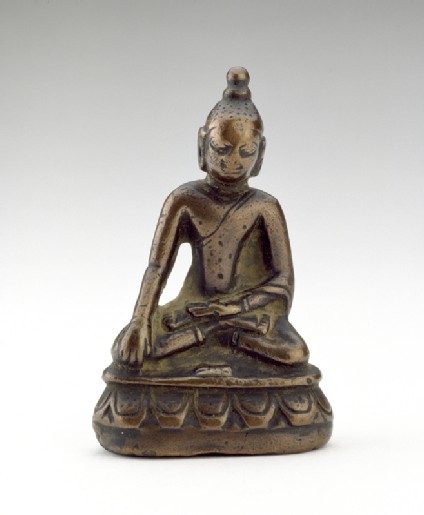Browse: 20 objects
- Reference URL
Actions
Figure of the Akshobhya Buddha
-
Details
- Associated place
-
Asia › Tibet › west Tibet (place of creation)
- Date
- 11th - 12th century (1001 - 1200)
- Material and technique
- bronze
- Dimensions
- 6.5 x 4.1 x 2.3 cm max. (height x width x depth)
- Material index
-
processed material › metal › alloy › copper alloy › bronze
- Technique index
- Object type index
- No. of items
- 1
- Credit line
- Purchased, 2000.
- Accession no.
- EA2000.30
-
Further reading
Heller, Amy, Early Himalayan Art (Oxford: Ashmolean Museum, 2008), no. 36 on p. 115, illus. p. 115
Location
-
- currently in research collection
Objects are sometimes moved to a different location. Our object location data is usually updated on a monthly basis. Contact the Jameel Study Centre if you are planning to visit the museum to see a particular object on display, or would like to arrange an appointment to see an object in our reserve collections.
Publications online
-

Early Himalayan Art
The identification of this seated Buddha as Akshobhya is determined by the small vajra at the feet of the statue, aligned with the edge of the lotus pedestal. The high proportion of copper in the alloy has made the sculpture very smooth and more subject to wear. The ushnisha is perfectly round and surmounted by a round jewel.
The head is also very round, the face oval with a high hairline and slightly receding chin. The facial features are no longer very sharp but the expression is placid, the eyes gently looking downward. The shoulders are broad but not athletic, and the body has slender proportions throughout. The monastic robe clings to the body, perfectly translucent except for the upper hem draped across the torso. The sleeve has a rounded hem which does not extend to the wrist but only to mid-forearm. At the wrist there is a bracelet, a plain band visible on both arms, though the right hand bracelet is now much abraded. The right hand makes the bhumisparsha mudra and the left hand is open and empty, resting in the lap. The hem of the robe is just marked by the rounded band at the ankles. There is only one row of broad and flat lotus petals [1]. The petals are only carved in the front, but the edge of the lotus pedestal is defined in the back as well. The body of the statue is fully carved in front, but has minimal detail at the back, a mere smooth silhouette. The base of the statue is sealed.
The high percentage of copper in the alloy suggests the influence of Nepalese craftsmen, as does the downward glance and the draping of the monastic robe (see cat. 5, 24). The treatment of the hair, broad facial features, and wide almond-shaped eyes reflect Kashmiri tendencies. These influences, together with the summary treatment of the back and pedestal, suggest a provenance from west Tibet, during the early period of the second diffusion of Buddhism, in the eleventh to twelfth century.
[Footnotes:]
1 For similar lotus petals, see the Vajrasphota in the Nyingjei Lam collection: Weldon and Casey Singer, The Sculptural Heritage of Tibet, pl. 14.
© 2013 University of Oxford - Ashmolean Museum

